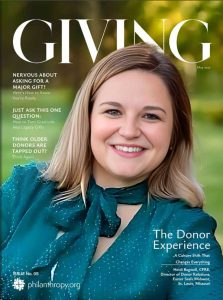
Heidi Bagwell, CFRE
Director of Donor Relations
Easter Seals Midwest
St. Louis, Missouri

What are the key components of creating a donor-centric culture within a nonprofit organization, and how can leaders ensure it’s maintained?
Creating and maintaining a donor-centric culture within a nonprofit organization is essential for fostering strong, lasting relationships with donors and ensuring the long-term success of fundraising efforts. A few key components for building this culture include:
- Understanding Donors’ Needs– A donor-centric culture places donors at the heart of the organization’s mission. This starts with the fundraiser understanding what motivates the donor, their values, beliefs, ideals, and the impact they wish to see through their contributions. Communication with donors is key to discovering this information.
- Personal Outreach– Most donors want to feel valued and appreciated. Tailored communication, whether in the form of thank-you notes, impact reports, or periodic updates, reinforces the personal connection donors feel to your cause.
- Transparency and Accountability– Donors want to know how their funds are being put to use and feel confident in the organization’s fund allocation. Being transparent and showing measurable impact fosters trust.
- Recognition Efforts– Most donors want to be recognized for their contributions, regardless of the gift amount. What matters most is that they are being recognized in a timely manner and in the way they prefer—even if that means anonymously.
- The Power of Gratitude– It’s about more than just saying “thank you.” A culture of gratitude makes this expression a core organizational value. Everyone organization-wide should participate.
- Continuous Engagement– Donor engagement does not end when the gift is received. When a donor gives, they signal their investment. It’s on us as fundraisers to use this as a stepping stone in our relationship with the donor.
- Consistently Seeking and Implementing Feedback– A donor-centric culture listens to feedback. You can do this through surveys, one-on-one meetings, focus groups, etc. The importance is not only listening, but also acting on the feedback.
These key components can be maintained through leadership commitment, staff education, and empowerment. Leaders must model and reinforce a donor-centric culture. All staff members should be educated on the importance of donors and empowered to prioritize donor satisfaction.
In your experience, what are the most effective strategies for retaining donors and building long-term relationships?
In addition to the key components above, here are a few strategies I’ve found most effective:
- Thank-you notes– Never underestimate the power of a handwritten note. Be prompt; the industry standard is within 48 hours of the gift.
- Offer engagement beyond giving– Donors should be offered ways to connect with your organization beyond financial support: volunteering, events, tours, surveys, etc.
- Transparency– Be clear about where donation dollars are going. A donor is more likely to support an organization that manages funds responsibly.
- Recognize and steward appropriately– Follow the donor’s lead on how they wish to be recognized. Offer exclusive benefits for higher-level donors when appropriate.
- Share impact– Regularly communicate the difference their donations are making. Use data, stories, and visuals to show results.
- Touchpoints without asks– Make it a point to reach out with messages that don’t include a solicitation. Focus on authentic, two-way relationships.
- Create a sense of community– Connect donors with each other through donor groups or events. This builds loyalty and can turn donors into advocates.
- Donor stewardship program– Consider creating giving groups that offer incentives for repeat giving, such as recognition tiers or a donor society.
- Solicit and implement feedback– Donors appreciate feeling heard and seeing their feedback drive change. Implementation is critical.
Several of these strategies can be implemented immediately. The key to retention is fostering long-term relationships through consistent, meaningful engagement.
How can nonprofits improve their communication strategies to make donors feel more valued and connected to the mission?
If you are not already, I highly recommend segmenting your communications. Tailor messaging based on giving history, interests, and affiliation. This helps donors feel more engaged.
Don’t be afraid to lean into technology. We recently started using our CRM to streamline acknowledgments. Look into what your CRM can do and whether you’re using it to its full potential.
Personalize communications. Use the donor’s name, focus on “you” rather than “we” language, and make subject lines compelling. Don’t forget to say thank you. You’d be surprised how many messages skip this entirely.
Ask how donors prefer to be contacted—and honor it. Not everyone wants a phone call or in-person meeting. Pay attention to engagement data: open rates, response rates, etc. This will offer clues into donor preferences.
Always mention impact. That’s what donors want to know. Show them how their support is making a difference, and they’ll remain invested.
Donor relations can sometimes feel intangible. How do you measure its success and communicate its value to stakeholders?
If you’re not tracking donor interactions in a CRM, start now. We say, “If it didn’t happen in the database, it didn’t happen.” Tracking even small interactions helps you measure engagement and tailor outreach accordingly.
Our KPIs include dollars raised, giving society members, corporate partnerships, and outreach volume. Comparing outreach to dollars raised provides insight into how activity translates into results.
Engagement tracking offers deeper understanding of a donor’s relationship to your organization. It helps identify who is likely to give time, talent, treasure, or testimony—and where they best align.
What do you think organizations often get wrong about the donor experience, and how can they improve?
Too often, organizations undervalue donor relations and take donors for granted. Limited resources cause stewardship to be overlooked entirely, leading to disengaged donors and declining support.
Improvement starts by recognizing the value of fundraising—and the relationships behind it. Fundraising isn’t a box to check; it’s a privilege. Donors could choose anyone, and they chose you.
Don’t assume repeat gifts without doing your part. A thank-you goes a long way. Focus on stewardship, not just solicitation—it costs more to acquire a new donor than to retain one.
The relationship begins with a gift. A donation signals interest and investment. That’s the moment to lean in, not step back.
As someone who’s passionate about this area, what changes would you like to see in how nonprofits approach donor relations over the next decade?
I’m intrigued by community-centric fundraising, which prioritizes community values over individual preferences and lifts marginalized voices. I’d love to see more research and real-world application of this approach.
I’d also like to see more accurate and relational job titles. “Director of Donor Relations” speaks directly to the work I do. Titles like “Major Gift Officer” can alienate donors or suggest that only large gifts matter.
We need more mentorship in this space and more programming from fundraising associations focused specifically on donor relations.
Ultimately, I’d love to see more organizations prioritize a true donor-centric culture where everyone—from leadership to program staff—takes part in the donor experience.